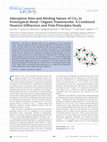Papers by Gadipelli Srinivas

Journal of Materials Chemistry, 2010
We report the first two examples of borohydride ammonia borane complexes: Li 2 (BH 4 ) 2 NH 3 BH ... more We report the first two examples of borohydride ammonia borane complexes: Li 2 (BH 4 ) 2 NH 3 BH 3 and Ca(BH 4 ) 2 (NH 3 BH 3 ) 2 . Their structures are successfully determined using a combination of X-ray diffraction and first-principles calculations. Both structures are composed of alternating layers of borohydride and ammonia borane. Examination of bond lengths indicates that this arrangement is stabilized via dihydrogen bonding between ammonia borane and their surrounding BH 4 À , and the interactions between ammonia borane ligands and cations. Our experimental results show that more than 10 wt% and 11 wt% hydrogen can be released from Li 2 (BH 4 ) 2 NH 3 BH 3 and Ca(BH 4 ) 2 (NH 3 BH 3 ) 2 , respectively. Negligible ammonia was detected compared to ammonia borane and its ammidoborane derivatives. Further improvements are needed to reduce borazine emission. Cycling studies show that decomposed Li 2 (BH 4 ) 2 NH 3 BH 3 and Ca(BH 4 ) 2 (NH 3 BH 3 ) 2 can be partially hydrogenated under hydrogen pressures at high temperatures.

Fuel and Energy Abstracts
Metal-organic framework Nanoconfinement Dehydrogenation kinetics Hydrogen storage a b s t r a c t... more Metal-organic framework Nanoconfinement Dehydrogenation kinetics Hydrogen storage a b s t r a c t We report controllable and enhanced hydrogen release kinetics at reduced temperatures in ammonia borane (AB) catalyzed by Zn-MOF-74. AB is loaded into the unsaturated Zn-metal coordinated one-dimensional hexagonal open nanopores of MOF-74 (ABMOF) via solution infiltration. The ABMOF system provides clean hydrogen by suppressing the release of detrimental volatile byproducts such as ammonia, borazine and diborane. These byproducts prevent the direct use of AB as a hydrogen source for polymer electrolyte membrane fuel cell applications. The H 2 release temperature, kinetics, and byproduct generation are dependent on the amount of AB loading. We show that nanoconfinement of AB and its interaction with the active Zn-metal centers in MOF are important in promoting efficient and clean hydrogen generation. (T. Yildirim).

In recent years, growing concerns about global warming and the environment have spurred an accele... more In recent years, growing concerns about global warming and the environment have spurred an accelerated development of materials technology for carbon dioxide (CO2) capture and storage. Two recent categories of materials being investigated for their CO2 storage capabilities are graphene oxide frameworks (GOFs) [1] and zeolitic imidazolate frameworks (ZIFs). We have synthesized graphene-oxide-frameworks (GOFs) by linking the OH groups on graphene oxide with benzene-boronic acids. Our initial GOF materials exhibit isosteric heats at low coverage of 32 kJ/mol for CO2. The nitrogen BET surface area of these initial materials is around 500 m2/g. Also, ZIFs are particularly useful for CO2 capture and storage due to high selectivities, CO2 uptakes and sample robustness. Neutron scattering and spectroscopic results of GOFs and select ZIFs with in-situ gas sorption will be presented. Neutrons are able to determine locations and strengths of binding sites. We will present detailed isotherms of carbon dioxide, methane and nitrogen at different temperatures of these interesting GOF and ZIF materials. [0pt] [1] J. W. Burress et al., Angewandte Chemie International Edition 49, 8902 (2010).

Journal of Physical Chemistry Letters, 2010
We report a detailed study of CO 2 adsorption in two important metal-organic framework (MOF) comp... more We report a detailed study of CO 2 adsorption in two important metal-organic framework (MOF) compounds (Mg-MOF-74 and HKUST-1). In both MOFs, the open metal ions were identified as the primary binding sites through neutron diffraction measurements. The relatively strong metal-CO 2 binding was attributed to an enhanced electrostatic interaction, and vibrational mode analysis shows that the adsorbed CO 2 molecule is strongly attached through one of its oxygen atoms while the rest of the molecule is relatively free. This high orientational disorder is the reason for the large apparent O-C-O bond bending angle derived from diffraction measurements. Our calculations give only a small degree of bond bending, suggesting that the CO 2 adsorption on the open metal site is still largely physisorption. Interestingly, the overall metal-CO 2 binding strength is right in the range which can facilitate both adsorption (CO 2 capture) and desorption (MOF regeneration) under typical flue gas conditions.

Uploads
Papers by Gadipelli Srinivas